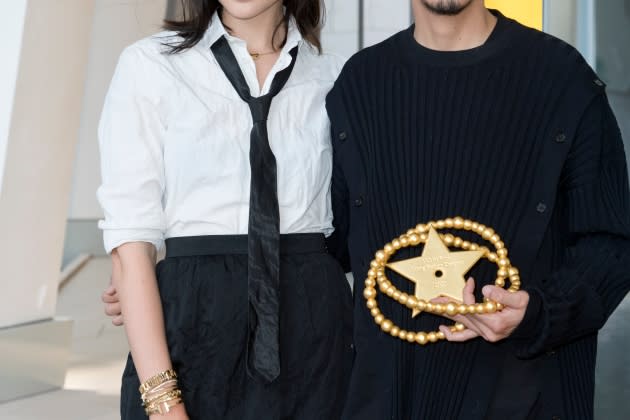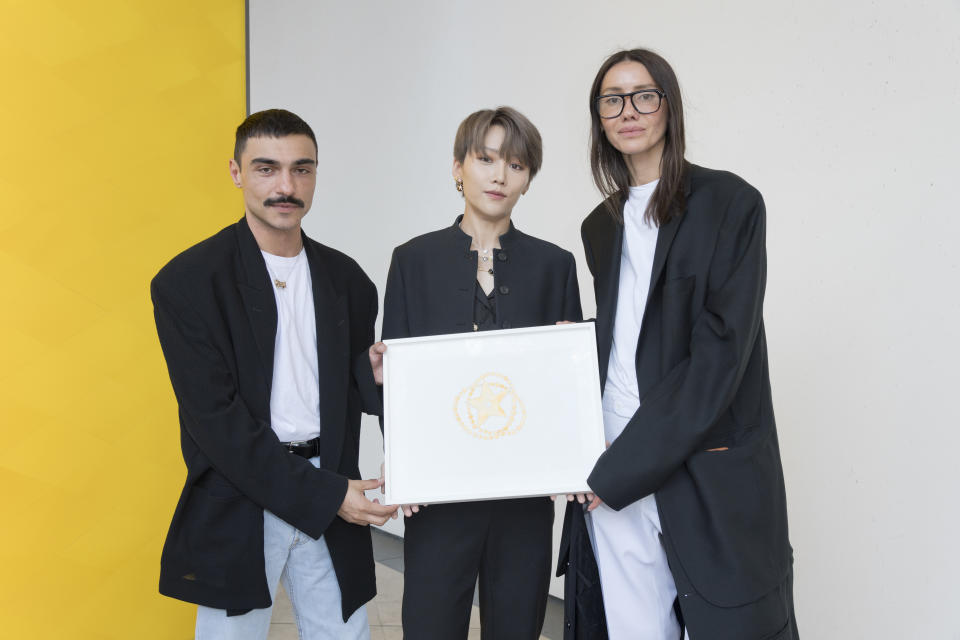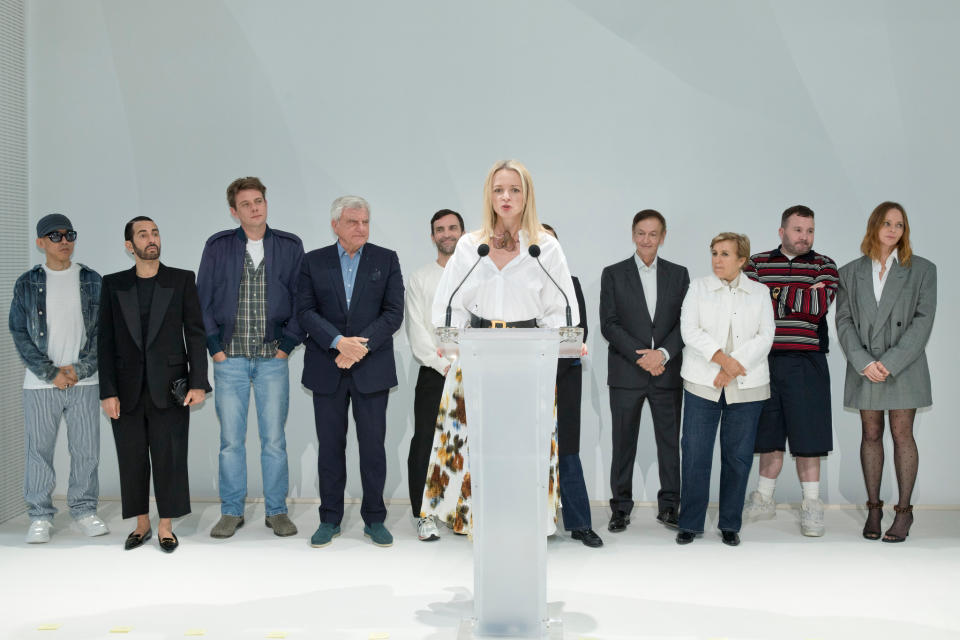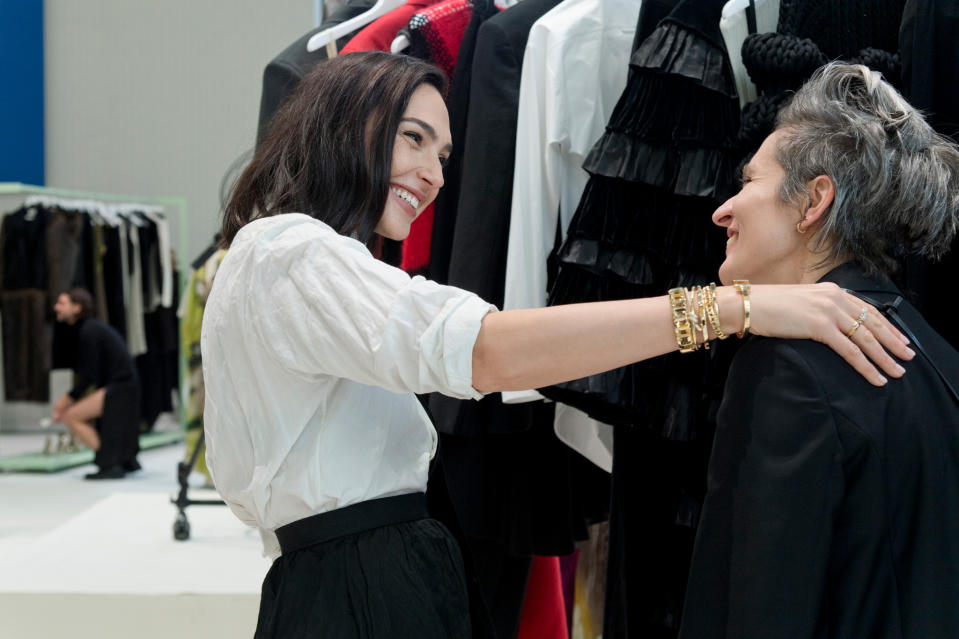Setchu Wins the 2023 LVMH Prize for Young Designers

PARIS — Setchu by Satoshi Kuwata, an industry veteran who has worked for everyone from a Savile Row tailor to luxury sneakers brand Golden Goose, on Wednesday won the 2023 edition of the LVMH Prize for Young Designers at a star-studded ceremony in Paris marking the 10th anniversary of the award.
Milan-based Kuwata beat some 2,400 applicants from 15 countries to walk away with a grand prize of 400,000 euros, plus a year of coaching from experts at luxury giant LVMH Mo?t Hennessy Louis Vuitton, parent of brands including Vuitton, Guerlain, Dom Pérignon and Sephora.
More from WWD
“I was a really naughty boy and my mom was really worried about me, and now I can make my mom really happy,” the 39-year-old designer said as he accepted the award.
Israeli actress Gal Gadot revealed the winner at Fondation Louis Vuitton in the presence of a jury featuring star designers Maria Grazia Chiuri, Kim Jones, Nigo, Silvia Venturini Fendi, Stella McCartney, Marc Jacobs, Nicolas Ghesquière and Jonathan Anderson.
Rounding out the group were senior executives Delphine Arnault, the force behind the prize and a key talent scout at LVMH; Sidney Toledano, chairman and chief executive officer of LVMH Fashion Group, and Jean-Paul Claverie, an adviser to LVMH chairman Bernard Arnault and LVMH’s head of corporate philanthropy.

Bettter by Ukrainian designer Julie Pelipas and Italian designer Luca Magliano’s Magliano label were the joint winners of the runner-up Karl Lagerfeld Special Jury Prize, presented by Chinese pop star Xin Liu, who drew a gaggle of screaming fans outside the venue.
Both designers will benefit from a grant of 200,000 euros and a one-year mentorship program from the LVMH Group.
Kuwata, who was born in Kyoto, Japan, and moved to London at the age of 21 to pursue a career in fashion, launched unisex label Setchu in 2020 after cutting his teeth at Huntsman in Savile Row during his studies at Central Saint Martins; Gareth Pugh in London; Kanye West and Givenchy in Paris; Edun in New York City, and Golden Goose in Milan.
“I wanted to do my own label since I was a kid, and it was a journey,” he said after taking a break to phone his parents in Japan to tell them the good news. “I just went different places because I knew I needed to do that to make a 360-degree design.”

His clothes are grounded in a deep knowledge and respect for different cultures and crafts, resulting in the brand’s fusion of Japanese and Western concepts in items like foldable jackets in origami-like constructions.
Kuwata said what makes his brand “unique” is a blend of artisanal fabrications, a modernist approach linked to his Japanese identity, and functional details inspired by his passion for fishing, which takes him to far-flung destinations like Gabon.
“It’s impossible to take a big suitcase and you also need to keep a space for fishing gear, but I don’t want to look like a fisherman wearing nylon garments,” he said, demonstrating how he transforms his ribbed sweater with rows of buttons to wear it three different ways.
Having grown up in an area known as the birthplace of Japanese whisky and for its clean water, he is highly attuned to the environmental impact of his brand and is opposed to runway shows. “It’s not really sustainable,” he objected. “I think it’s time to change.”
However, he has old-fashioned ambitions for Setchu. “I want LVMH to teach me how to make it a heritage company for the future. There will be another part,” he promised.
The designer, who runs his brand solo, plans to hire a team with the ambition of growing his e-commerce activity and launching sneakers, other shoes and handbags. “I used to design a lot and I’m good at it. It just needed money,” he said.
Chiuri said she was so impressed by Kuwata’s presentation that she slipped on one of his jackets, pronouncing it as well-made as an haute couture creation.
“It’s magnificent. It’s light, it fits well,” she said. “Everything was perfect. It’s not only about the clothes, it’s more about — in my point of view — philosophy, what it means for him to have clothes, maintain your heritage but in a modern way, timeless, high quality, thinking about the environment.”
Delphine Arnault, who earlier this year was named chairman and CEO of Christian Dior Couture, said the jury was unanimous. “He did an outstanding presentation,” she opined, noting that Kuwata had almost reached the age limit for applicants, although she added: “Mr. Dior started his brand when he was 42, so it gives him hope.”
The LVMH Prize is open to designers under age 40 who have presented and sold at least two collections of women’s, men’s or unisex ready-to-wear. Arnault said she was proud to see how it’s become an industry reference over the last decade.
“There’s been so many amazing designers who have gone through the prize and who have developed their career in a great way, be it in the group or not,” she said, reeling off names including Simon Porte Jacquemus, Marine Serre, Steven Stokey-Daley and Grace Wales Bonner.
Not only are more people than ever applying for the prize, but it has changed in keeping with the industry’s evolution, reflecting luxury’s move toward genderless creations, streetwear and sustainable designs, Arnault noted.

Asked why LVMH decided to raise the endowment of the main prize to 400,000 euros from 300,000 euros previously, and the Karl Lagerfeld prize to 200,000 euros from 150,000 euros, she ventured: “Because of inflation?” The executive made the surprise announcement during the ceremony.
“It hadn’t been raised in a long time and I think that it really helps,” Arnault said, noting that designers struggle with cash flow issues because they have to advance money for fabrics and production before being paid by wholesale buyers, and also need funds to hire staff and hold runway shows. “Most of them have either one or two employees, or zero employees.”
She said it was doubtful whether the prize could evolve in future to include other categories, such as accessories, noting that it was already very time-consuming. And she admitted to feeling a little nostalgic for the days when the late Lagerfeld took part in jury deliberations around lunch with her father, Bernard Arnault.
“I really miss Karl when I live those moments because he was there since Day One; he was so important to the prize,” Arnault reflected. “He was always very generous with his time and his advice.”
Toledano praised this year’s crop for putting the emphasis on sophisticated, wearable designs.
The 2023 edition’s finalists also included U.S.-based brands Luar by Raul Lopez and Diotima by Jamaican designer Rachel Scott; London-based Aaron Esh, and Paolina Russo by Canadian designer Paolina Russo and French designer Lucile Guilmard; Paris-based designer Bur? Akyol, and Italian label Quira by Veronica Leoni.
“We’ve had years when people were more focused on streetwear, but this time we saw the return of silhouettes, elegance and materials,” Toledano said. “Some use recycled materials, others don’t. But globally, they have the potential to be great designers.”
Pelipas said she was grateful for the opportunity to introduce her brand, which is rooted in an upcycling system that reworks secondhand garments and deadstock materials.
Now based in London as a result of the Russian invasion of her country, the former fashion director of Vogue Ukraine is looking to make connections that will allow the label to scale and become a solution for the stock currently clogging brands.
“We have a chance to rebuild our system of production and we have to consider that and not ignore it as we did before,” she told WWD. “I hope with this example, the overall industry will shift toward upcycling.”
She plans to invest the prize money into technology. “Right now, we’re in a place where we have all the necessary data, but we need more investment to put it into software and apply it in all the productions we’re working with.”
Picking up his award, Magliano told the crowd of industry heavy hitters: “It’s a beautiful feeling to be seen.” His meticulous take on downbeat, vintage-looking menswear has been gaining traction on the Milan scene, thanks to the Italian designer’s tailoring and color sense.
He plans to hire people for his studio in his native Bologna. “We want to do womenswear. It’s something that we really want to do, so we need to enlarge ourselves,” he said.

Gadot, wearing a black-and-white Dior outfit with stacks of gold Tiffany & Co. bangles, said she was glad to lend visibility to the young designers’ ambitions. “Whenever I have the opportunity to support the new generation, the future artists, the future talent, I will always be happy to do so,” the “Wonder Woman” star told WWD.
As an actress, Gadot is particularly sensitive to the power of clothes. “Oh, wow, it’s big. It’s like a part of the personality of the character. It helps build up and create who the character is, what’s the world she’s living in,” the Tiffany brand ambassador said. “And then on the red carpet, we really get to have fun.”
— With contributions from Lily Templeton
Launch Gallery: Inside the LVMH Prize Awards
Best of WWD
Solve the daily Crossword

